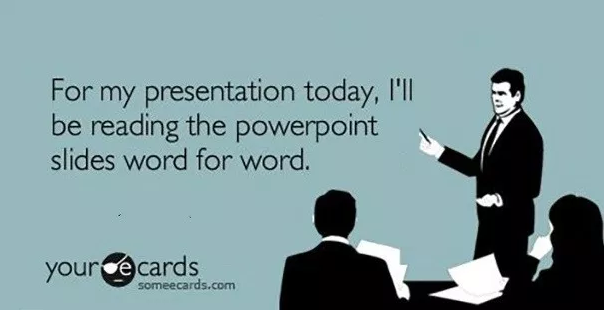One of the frequent errors that I see first time founders make is putting wayyy too many words on a slide. If that isn’t bad enough, some founders then proceed to read every word on the slide as though it’s a script. I saw a blog post by marketing guru and former college classmate, Seth Godin, that worded an admonishment more elegantly than I ever could. He said: “don’t use Powerpoint as a sort of teleprompter”.
If you’re reading your pitch deck slides, why do I need you?
For years, I’ve been teaching students and clients that they should never read from their slides, but I’ve never seen or heard the directive so well worded. As soon as you hear it, you get it.
But even when you understand what you shouldn’t do, it’s worth reminding you why this is such an important directive. Founders that read from their slides do it for different reasons, including “they didn’t know better” and “they didn’t memorize a script”. Regardless of the reasons, founders need to know that reading from your slides sends all sorts of horrible signals to your audience and makes your presentation way less effective.
In terms of what signals you send to your audience, let’s start with why you are giving a funding pitch in the first place and what you hope to achieve. If you are the one giving the pitch, it usually means that you’re the CEO, or at the very least, one of the co-founders of an early stage company. You are trying to convince one or more people that you are a smart professional who is capable of doing hundreds of complex things to turn a small business into a big business. Almost all of those things are harder than memorizing and preparing to give a short presentation.
From an investor’s perspective, the three most obvious reasons you are reading your slides are: (1) You don’t know the basics of making presentations; (2) You didn’t put in the time to do the presentation well; or (3) You aren’t capable of memorizing your own pitch. Since growing the business will involve selling to a lot of people, including potential partners, other investors, clients, etc., a CEO’s inability to pitch doesn’t instill a great sense of confidence in that CEO.
The pitch is often the CEO’s first opportunity to make a good impression. So giving a strong pitch isn’t just important, it’s critical. This is your chance to give a small glimpse into the many things that you are capable of doing well. Don’t trip on the starting line.
Should I be listening or reading?
I also mentioned that reading from your deck makes the deck less effective. That’s because the brain can’t do two things at once equally well. When you have enough text on your slide to use it as a teleprompter, your audience gets sucked into trying to read the words on your slide as well. The fact is that they can’t read the slide and pay attention to you at the same time. Where do you want their attention? Ideally, it should be on you. The slide’s purpose is to make an impression and emphasize a single takeaway, not to steal attention away from you.
Each slide in your deck should be designed to make one point powerfully. Examples include: “This is a huge market”, “We have an experienced team”, “We’ve got customer validation”, “Our tech is bleeding edge and patented”, “Our revenues are growing”, etc. There should just be enough words or visuals on the slide to support that takeaway. Use your words to give the takeaway some texture.
Your pitch script and your pitch deck are partners. They are two different things designed to work well together. You will deliver the pitch and your slides will make sure that your most important points are the things that get remembered. Use your body language, eye contact, voice, and confidence to keep the audience engaged and show them why investing in you is a good bet. Investors invest in founders, not in pitch decks.
Now go get ‘em!
Edited from an article I originally posted on LinkedIn


I love this! You’re spot right on!